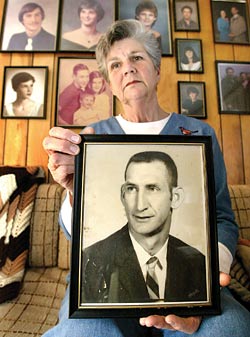What’s a life worth? Asbestos exposure and its connection to money, politics and power
By Jessica Centers and Matthew Korade
Anniston Star, March 27, 2005

Julia Golden holds a picture of her late husband, Bob Golden, who was diagnosed with lung cancer in 1977. Bob, a former Capco Pipe Co. Inc. employee, lived with the disease for 16 years. Photo: Stephen Gross/The Anniston Star
The names are written in a woman’s neat script.
They tally the friends and family she’s seen die because of asbestos, men who’d earned a living believing they were safe, eventually learning, too late, that they weren’t.
The list serves as a sober illustration of the complex nature of asbestos injury and a legal system that wrestles with compensating the sick and dying.
In the next few weeks, the U.S. Senate is expected to consider a bill that would do away with asbestos lawsuits past, present and future. The legislation, which President Bush alluded to in his State of the Union address with the phrase “frivolous asbestos claims,” presents a complex network of connections running from Ragland, a small town in St. Clair County, throughout U.S. industry to Washington, D.C.
The people in St. Clair County are the human face of that legislation. Evidence has shown that asbestos companies intentionally injured employees, that the industry built the bulk of its profits off keeping workers in the dark about the dangers of asbestos. Those profits grow by millions each day, even among companies who filed for bankruptcy because of the lawsuits.
It is for those sick and dying, the survivors say, that citizens need to be aware of this law. They say their lives are not frivolous and are worth more than money.
Want To Find Out More?
Call us toll-free at 1-800-998-9729
